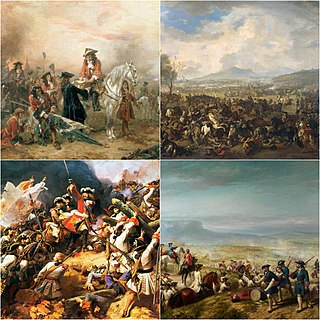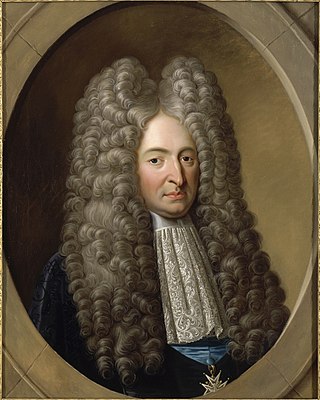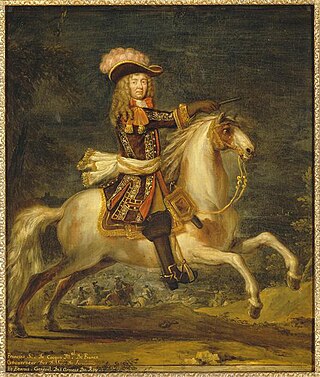Related Research Articles

Louis XIV, also known as Louis the Great or the Sun King, was King of France from 1643 until his death in 1715. His verified reign of 72 years and 110 days is the longest of any sovereign. Although Louis XIV's France was emblematic of the Age of Absolutism in Europe, the King surrounded himself with a variety of significant political, military, and cultural figures, such as Bossuet, Colbert, Louvois, Le Brun, Le Nôtre, Lully, Mazarin, Molière, Racine, Turenne, Condé, and Vauban.

The War of the Spanish Succession was a European great power conflict fought between 1701 and 1714. The immediate cause was the death of the childless Charles II of Spain in November 1700, which led to a struggle for control of the Spanish Empire. His nominated heir was Philip of Anjou, a grandson of Louis XIV of France, whose main backers were France and most of Spain. His rival, Archduke Charles of Austria, was supported by the Grand Alliance, whose primary members included the Holy Roman Empire, the Dutch Republic, and Great Britain. Significant related conflicts include the 1700 to 1721 Great Northern War, and Queen Anne's War in North America.

The Palace of Versailles is a former royal residence commissioned by King Louis XIV located in Versailles, about 19 kilometers (12 mi) west of Paris, France.

James Francis Edward Stuart, nicknamed the Old Pretender by Whigs, was the son of King James VII and II of England, Scotland and Ireland, and his second wife, Mary of Modena. He was Prince of Wales from July 1688 until, just months after his birth, his Catholic father was deposed and exiled in the Glorious Revolution of 1688. James II's Protestant elder daughter Mary II and her husband William III became co-monarchs. The Bill of Rights 1689 and Act of Settlement 1701 excluded Catholics such as James from the English and British thrones.

Nicolas Catinat was a French military commander and Marshal of France under Louis XIV.

Michel Chamillart or Chamillard was a French statesman, a minister of King Louis XIV of France.

Events from the year 1710 in Canada.

The Hall of Mirrors is a grand Baroque style gallery and one of the most emblematic rooms in the royal Palace of Versailles near Paris, France. The grandiose ensemble of the hall and its adjoining salons was intended to illustrate the power of the absolutist monarch Louis XIV. Located on the first floor of the palace's central body, it faces west towards the Palace Gardens. The Hall of Mirrors has been the scene of events of great historic significance, including the Proclamation of the German Empire and the signing of the Treaty of Versailles.

The Kingdom of France in the early modern period, from the Renaissance to the Revolution (1789–1804), was a monarchy ruled by the House of Bourbon. This corresponds to the so-called Ancien Régime. The territory of France during this period increased until it included essentially the extent of the modern country, and it also included the territories of the first French colonial empire overseas.

Louis de Bourbon, Comte de Soissons was the son of Charles de Bourbon, Count of Soissons and his wife, Anne de Montafié, Countess of Clermont-en-Beauvaisis. A second cousin of Louis XIII of France he was a prince du Sang, those considered part of the Royal family. Part of the faction who opposed Cardinal Richelieu and his policy of war with Spain, he was killed leading a revolt at the Battle of La Marfée in 1641.

The Kingdom of France is the historiographical name or umbrella term given to various political entities of France in the medieval and early modern period. It was one of the most powerful states in Europe since the High Middle Ages. It was also an early colonial power, with colonies in Asia and Africa, and the largest being New France in North America.

The Barrier Treaties were a series of agreements signed and ratified between 1709 and 1715 that created a buffer zone between the Dutch Republic and France by allowing the Dutch to occupy a number of fortresses in the Southern Netherlands, ruled by the Spanish or the Austrians. The treaties were cancelled by Austria in 1781.

François de Blanchefort de Créquy, later Marquis de Marines, 2 October 1629 to 3 February 1687, was a 17th-century French noble and soldier, who served in the wars of Louis XIV of France.

The ancien régime, now a common metaphor for "a system or mode no longer prevailing", was the political and social system of the Kingdom of France that the French Revolution overturned through its abolition in 1790 of the feudal system of the French nobility and in 1792 through its execution of the king and declaration of a republic.

César de Bourbon, Légitimé de France was the illegitimate son of Henry IV of France and his mistress Gabrielle d'Estrées, and founder of the House of Bourbon-Vendome. He held the titles of 1st Duke of Vendôme, 2nd Duke of Beaufort and 2nd Duke of Étampes, but is also simply known as César de Vendôme.

Louis de Bourbon, Légitimé de France, Count of Vermandois, born Louis de La Blaume Le Blanc, also known as Louis de/of Vermandois was a French nobleman, illegitimate but legitimised son of Louis XIV, King of France by his mistress, Louise de La Vallière. He died exiled and disgraced at the age of 16, unmarried and without issue.

The French Royal Army was the principal land force of the Kingdom of France. It served the Bourbon dynasty from the reign of Louis XIV in the mid-17th century to that of Charles X in the 19th, with an interlude from 1792 to 1814 and another during the Hundred Days in 1815. It was permanently dissolved following the July Revolution in 1830. The French Royal Army became a model for the new regimental system that was to be imitated throughout Europe from the mid-17th century onward. It was regarded as Europe's greatest military force and the most powerful armies in the world for much of its existence.
Charles-Édouard Levillain, FRHistS, MAE, is a French historian of early modern Britain and the Low Countries. He is currently professor of British history at Université Paris Cité.

The Battle of Chelif or Battle of Djidouia took place on 28 April 1701 on the banks of the Chelif River. It was fought between the armies of the Alaouite Sultan Ismail Ibn Sharif and those of the Regency of Algiers commanded by the Bey of Mascara, Mustapha Bouchelaghem. It took place in the context of an attempt by the Alaouites to conquer the west of the Regency of Algiers, coordinated with an offensive by Tunis on the east of the Regency of Algiers in 1700 and 1701.
Antoine Vallot was a French doctor. He was First Physician to King Louis XIV. Antoine Vallot had succeeded François Vautier, or Vaultier, as the king's first physician. Antoine d'Aquin succeeded him in 1672.
References
- ↑ "Archived copy". Archived from the original on 16 July 2011. Retrieved 5 January 2008.
{{cite web}}: CS1 maint: archived copy as title (link) - ↑ The Society for the Study of French History
- ↑ Centre for French History and Culture
- ↑ The Dynastic State and the Army under Louis XIV - Cambridge University Press